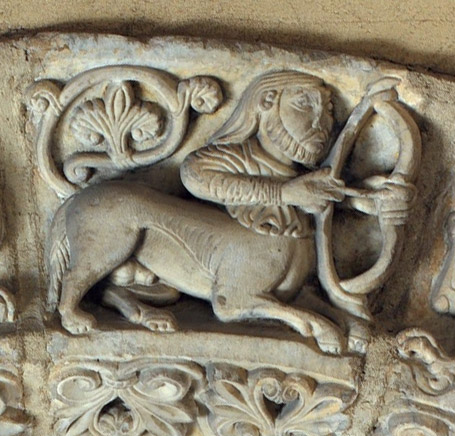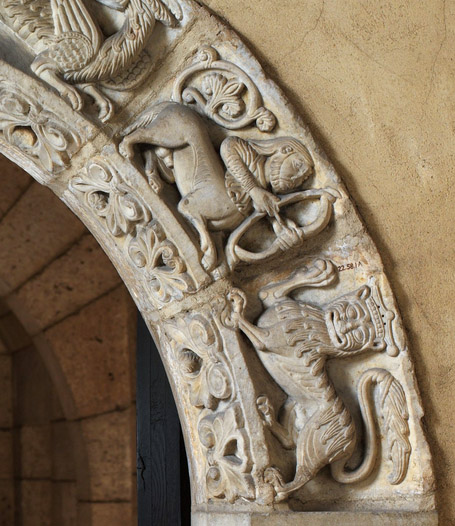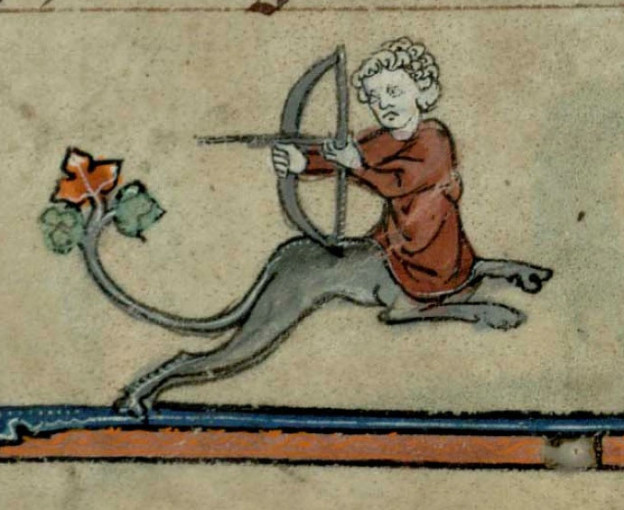|

. . . . .

|
Next, from the Cloisters of the Metropolitan Museum of Art, is this fine fellow, a sagittary carved over a doorway in a parade of fantastical creatures. Ironically, I once went wemic hunting in person at the Cloisters, but somehow I missed him!
The Arch with Beasts dates to around 1150-75, reportedly from a church in Narbonne, in the Languedoc-Rousillon region of France, on the coast of the Mediterranean Sea. Although the museum describes him as a centaur, he has leonine features. He paws are a little hoof-like, but each one ends in three toes, not true hooves. His tail is cat-like ... well, one of them is. Does he also have a horse's tail hanging down behind? He is pictured, as were most sagittaries of the time, with a bow. And with his beard and leonine endowment, he is very clearly male.
Well, his tail, his cat-tail, actually has great floral extrusions erupting from it. What the heck is that about? And actually, both here and above, and in other examples, sagitarries are drawn with remarkable tails that sprout leaves and flowers along their lengths.
And these floral tails are not all that unusual in sagittaries nor in lions in general, as depicted for the period. Check out this bipedal lion-man fiddler. And look at the sagittaries on the coat of arms of King Stephen. More often than not, lions in heraldry have floral tails.
But here's a funny point to ponder. The medieval sculptor who carved the Arch of Beasts put a true lion right next to the sagittary. And the lion has a conventional lion's tail, with one tuft at the end. The artist made his lion with a straight tail, and his sagittary with a flowery one. Maybe because he only knew of sagittaries from heraldry? He is, over all, a very odd sagittary.
Take a look at him here, next to his pal, the king of beasts. Sagittary with a flower tail; lion with a sort-of lion tail.
Update 29 June 2016: Check out this March 2016 blog post on floral tails in medieval art at The Voynich Portal called A Tail in Several Cities. Money quote:
It’s not unusual to find a feathered tail on images of animals that look like lions ... [T]he Imperial Roman era had quite a tradition of embellishing tails—especially those of sea critters (including fish-legged gods). Even dolphins, which are not fish and do not have fish tails, were created with flower-like tails ...
[F]ancy tails are everywhere. Roman flower-tails have been found in every corner of the realm from Rome to Turkey and Tunis to England. The tradition appears to have inspired manuscript artists in later years, as parchment became more widely available. Embellished tails can be found in marginalia in many manuscripts and not just on sea-critters, the idea expanded to include many forms of mythical beasts, gods, and hybrids.
The author goes on to give this example ... and it turns out to be a wemic!

The author gives as his source only "Ms Trinity B-11-22" -- and what that means I do not know.
Update 30 Aiug 2016: Okay, the author of that post is a helpful person named J.K. Petersen. That medieval wemic came from the The James Catalogue Of Western Manuscripts at Trinity College. The particular source for that wemic is Trinity Manuscript B.11.22. The work is written in Latin and Medieval Dutch, in the 13th and 14th centuries. There are so many great wemics in here, as well as lions and feline bipeds, that I've decided to put them in another post, coming soon.
|